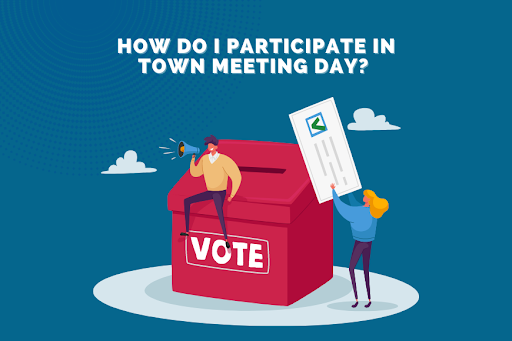
Vermont town meeting is a tradition dating back to the mid-1700s. Town citizens in Vermont held meetings to address the issues they faced collectively. Town meeting was, as it still is today, an opportunity to socialize and meet new neighbors and community members. It brings people together who may not have otherwise crossed paths. This strengthens social ties within a town and helps solve community problems.
Town Meeting Day happens every year on the first Tuesday in March; it’s also an opportunity to lend support to different projects, budgets, and local organizations. For example, last fall, many towns showed their support for local non-profits by waiving the petitioning process due to concerns of Covid-19 spread, and workforce shortage. The petitioning process can be burdensome on the organizations because they simply do not have the manpower to go out into the community and collect the signatures required to be put on the ballot. Waiving this process ensures that organization budget requests from individual towns will be placed on the Town Meeting Day ballot, without collecting signatures. This action may seem like a small gesture, but it provides great capacity for local nonprofits to achieve positive outcomes. Our hope is that we can continue to ease this process so that our non-profit organizations can continue to focus on the incredibly important work that they do. Many of these agencies will appear on your local town ballot; organization leaders will likely be presenting to your towns and cities in preparation for Town Meeting Day voting.
Participating in Town Meeting Day and voting can be stressful. You may not know where to go or how to register to vote. Here is an easy guide to participating:
Registering to Vote:
- Must be 18 years of age or older
- Using Vermont’s Online Voter Registration system, or
- Submitting a voter registration form to your town or city clerk
- When registering you will need to input your driver’s license number or the last four digits of your social security number. When registering to vote for the first time, you will need to take the Voter’s Oath (the Oath can be self-administered and is contained on the online and paper applications).
- You can also call 1-800-439-VOTE for assistance
- You can check your registration status anytime online here
Know what you are voting for:
- Every year, 30 days before a town meeting, a “town warning” will be displayed at several locations within your town. The town warning will describe where and when Town Meeting Day will occur, and what will be on the ballot that you will be voting on.
- It is important to do your research before you cast your vote in order to make informed decisions and decide what will be the best for your town.
Voting in Person:
- Find your polling place here. Your polling place is in the town that you currently live in. A voter can only be registered to vote in one town.
- Towns can vote in two different ways at the March town meeting – by floor meeting or by Australian ballot. Most towns use a combination of both voting methods.
- Australian ballot voting takes only a few minutes per person. It takes place at a polling place where voters mark a secret ballot which is counted when the polls close. This is also how we cast our ballots at the general election in November. Town Boards of Civil Authority (BCA) determine when the polls open in the morning (between 5:00 a.m. and 10:00 a.m.). All polls must close at 7:00 p.m.
- Some towns allow voters to cast their vote through an absentee ballot. This means that someone can go and pick up a blank ballot, fill it out at home, and then either drop it off at the polling location or send it in through the mail. Guidelines for absentee ballots vary based on where you live. Contact your town clerk for more information.
Floor Meeting:
- The floor meeting is what we generally picture a Vermont town meeting to be like – it is when people gather together at a public meeting place like the town hall or local school to discuss and vote on issues. Floor meetings can last a few hours – or they can go all day. The length of the meeting depends on how many articles are on the warning and how much discussion there is over the issues raised by the articles. Citizens speak directly for themselves, seeking to clarify or amend items to be voted on, or to persuade those present on whether or not to vote for a particular measure.
Be proud of yourself for practicing civic engagement. Attending town meetings and voting is your way of showing support for your community, the issues, and the organizations you are passionate about.
Information in this blog and on Town Meeting Day can be found on the Vermont Secretary of State’s website: “Citizen’s Guide to Town Meeting”.